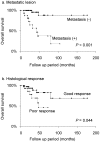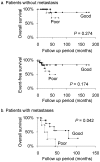Prognostic value of histological response to chemotherapy in osteosarcoma patients receiving tumor-bearing frozen autograft
- PMID: 23977028
- PMCID: PMC3744566
- DOI: 10.1371/journal.pone.0071362
Prognostic value of histological response to chemotherapy in osteosarcoma patients receiving tumor-bearing frozen autograft
Abstract
Background: A variety of surgical procedures are now available for tissue reconstruction after osteosarcoma excision, and an important prognostic factor is the evaluation of response to chemotherapy using histology. Although tumor-bearing autografts are useful tools for reconstruction, re-use of the primary tumor may make it difficult to assess the histological response to chemotherapy, since the entire tumor cannot be analyzed. Here, we analyzed the prognostic value of the histological response in the patients who received frozen tumor-bearing autografts for reconstruction.
Method: Retrospective analysis of the medical records of 51 patients with high-grade osteosarcoma of the extremities was performed. All patients received reconstruction using frozen tumor-bearing autografts. Tumor necrosis was evaluated in extraskeletal masses and cancellous bone.
Results: Five-year overall survival of patients with good and poor response to chemotherapy was 82.9% and 46.4%, respectively (P = 0.044), and 5-year event-free survival was 57.7% and 36.0%, respectively (P = 0.329). Multivariate analysis revealed that a poor histological response to chemotherapy was a significant prognostic factor for overall survival (P = 0.033).
Conclusion: Histological response is an important and reliable prognostic factor in patients undergoing reconstruction using frozen tumor-bearing autografts.
Conflict of interest statement
Figures




References
-
- Chen WM, Chen TH, Huang CK, Lin CF, Shih LY, et al. (2000) Treatment of high-grade primary osteosarcoma in extremities: 15-year clinical experience in VGH-Taipei. J Orthop Surg 17: 11–16.
-
- Chen WM, Chen TH, Huang CK, Chiang CC, Lo WH (2002) Treatment of malignant bone tumours by extracorporeally irradiated autograft-prosthetic composite arthoplasty. J Bone Joint Surg Br 84: 1156–1161. - PubMed
-
- Chen WM, Wu PK, Chen CF, Chung LH, Liu CL, et al. (2012) High-grade osteosarcoma treated with hemicortical resection and biological reconstruction. J Surg Oncol 105: 825–829. - PubMed
-
- Grimer RJ (2005) Surgical options for children with osteosarcoma. Lancet Oncol 6: 85–92. - PubMed
-
- Tsuchiya H, Tomita K, Minematsu K, Mori Y, Asada N, et al. (1997) Limb salvage using distraction osteogenesis. A classification of the technique. J Bone Joint Surg Br 79: 403–411. - PubMed
MeSH terms
Substances
LinkOut - more resources
Full Text Sources
Other Literature Sources
Medical

